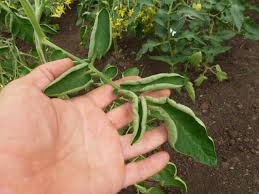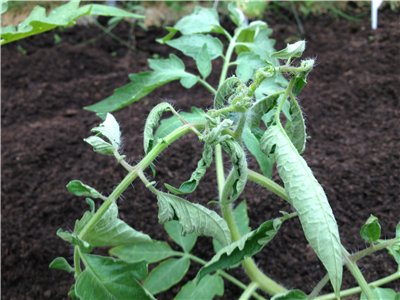 Often, after planting tomato seedlings, gardeners begin to worry about what tomato diseases in seedlings are: leaf twisting, and how to deal with it. There can be many reasons, we will deal with everything in order.
Often, after planting tomato seedlings, gardeners begin to worry about what tomato diseases in seedlings are: leaf twisting, and how to deal with it. There can be many reasons, we will deal with everything in order.
The first is a natural process that is characteristic of some varieties of tomatoes, such as Honey Drop or Fatima. Look, if all the plants of this variety have the same twisted leaves, then there is no need to worry. The second - there may be a reason because when you transplanted the seedlings, you slightly damaged the roots, and the plant stopped, twisted leaves, trying to restore the root system. When the process is established, the leaves will return to normal.
Lack and excess of moisture
The leaves may well curl for this reason, so the plant tries to protect the moisture that it has, folds the leaves in hot weather in order to reduce evaporation, in the evening or in cloudy weather, it unfolds them to be saturated with dew. Take a closer look if the leaves have opened at night - which means the reason is this.
How to deal: to intensify watering, but not by leaflets, it is harmful for them, in the heat they will get burned, with morning watering they can lead to late blight. However, evening watering over the leaves by sprinkling can also lead to this. It is better to water under the root, though every 3 days, but abundantly. This is because the roots go deep in the tomato, and surface watering, albeit everyday, will not produce results.
The same picture may seem with an excess of moisture, especially for clay soils, when during heavy rains the moisture slowly goes deeper, and the tomatoes suffocate without receiving oxygen. Take the grooves away from the plants so that the excess moisture goes away.
Find out, which varieties of tomatoes are better total for growing in a greenhouse in the suburbs.
Few nutrients

Not all gardeners are responsible for their plants, many on the principle of planting and forgetting. But, plants, like people, also want to drink and eat, and on bare, empty land they will also starve, showing their dissatisfaction in their own way, and trying to show the owners that they feel bad. Once every two weeks you need to feed the plants, they themselves suggest what they lack:
- If the leaves of the tomatoes turn red-violet in color, they obviously lack phosphorus.
- Fragile leaves are bent down - not enough zinc.
- The leaves curl and brighten - feed them with boron.
- They fold into a tube, become smaller - we need sulfur with copper.
- The leaves curl up and turn pale - you need calcium.
- Thin saggy leaves - urgently require iron!
It happens that the symptoms are so similar that it’s hard to understand exactly what your tomatoes want. Then do it simply - take zircon or epin (the first is better for hot weather, the second for cool), and process the plants. You can also add one treatment with Mortar and your tomatoes will come to life.
Overabundance of nutrients
Yes, tomatoes can also hurt from this, especially if you overdo it with not overripe manure or saturated herbal infusions. A raspberry cannot absorb all the nutrients, twists the leaves, reducing photosynthesis. Excess nitrogen will lead to a lush green mass, and the crop will not wait for a normal one. The plant twists the leaves, thickens the stem, powerful stepsons climb from everywhere. This is a bell - there is a lot of nitrogen in the soil, the picture needs to be greased. This can be done with ash. Open a glass in a bucket and sprinkle with warm infusion.If there is no ash, take a teaspoon of potassium sulfate, and dissolving in a bucket of water, treat the plants.
If you don’t like to mess around, read: Tomathouse.com - Learn a lot of interesting things!
Heat

If your seedlings in a greenhouse began to twist leaves, pay attention to what is the temperature there? If it is too hot - this is a natural process, the plant tries to defend itself. Add airing, additionally cover with lutrasil, treat with urea (1 l / bucket of water), then - with potassium permanganate in a couple of days.
Viral diseases
There are many of them - bacterial cancer, fusarium, tobacco mosaic, verticillosis, etc. Sick plants need to be removed, burned, and the remaining tomatoes and soil treated with potassium permanganate or copper chloride. With fungal diseases, you can take any of the antifungal drugs and save the plants by processing them a couple of times.
Insects
Often aphids attack the tomatoes, a whitefly or spider mite settles. You need to inspect the plants for twisting the leaves, on the back of the leaves you can see insects, and you need to treat them with insecticides, because insects suck the juices from the plant, and even inject the poisons into them, which is why they react by twisting the leaves.
By the way, read: how to grow a watermelon in the Moscow region in open ground.




 Low-growing tomatoes, without pinching: 5 of the most delicious varieties
Low-growing tomatoes, without pinching: 5 of the most delicious varieties Why tomato seedlings grow poorly
Why tomato seedlings grow poorly We grow a tomato in a shell
We grow a tomato in a shell Growing tomatoes without watering according to the method of Kazarin
Growing tomatoes without watering according to the method of Kazarin
Clara
The leaves of a tomato plant dry and become thin. What to do with it?